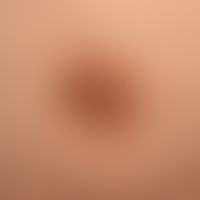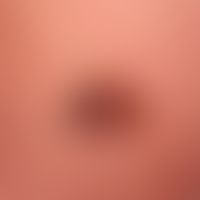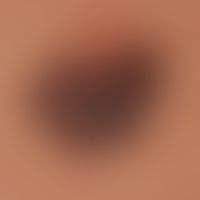Image diagnoses for "Torso", "Plaque (raised surface > 1cm)", "brown"
86 results with 240 images
Results forTorsoPlaque (raised surface > 1cm)brown

Circumscribed scleroderma L94.0
Generalized circumscribed scleroderma: large-area evenly indurated sclerosis of the skin, skin with a shiny, reflective surface.

Naevus melanocytic common D22.-
Common melanocytic nevus:Symmetrically structured melanocytic compound nevus of junctional and dermal cell nests with basal maturation coveredby papillomatous squamousepithelium. The nests are superficially discontinuously pigmented, accompanied by melanophages. The squamous epithelium is narrowed and with elongated reticules, covered by lamellar hyperkeratosis.
Extension along the hair follicles in strands, here partly neuroid cytomorphology of melanocytes.

Acrokeratosis paraneoplastic L85.1
Acrokeratosis paraneoplastic: acquired, symptomless, brownish verrucous hperkeratosis of the nipples.

Melanoma superficial spreading C43.L
Melanoma malignes superficially spreading: pigmentation mark known and growing for years. No subjective complaints. The melanoma grows asymmetrically (no axial symmetry) with irregular pigmentation and depigmentation zones.

Nevus spitz D22.-
Naevus Spitz: Incident light microscopy of the tumor clinically shown above; irregular pigmentation; black dots.

Radiodermatitis chronic L58.1
Chronic radiodermatitis: Condition following radiation of a bronchial carcinoma.

Galli-galli disease Q82.8
Galli-Galli, M. Disseminated, spotted, partly also confluent red-brown spots, papules and plaques.

Melanoma superficial spreading C43.L
Melanoma, malignant, superficially spreading: superficially spreading malignant melanoma. Enlargement stage of the preliminary picture. Moderately sharply edged, brown-black plaque. No complaints.

Kaposi's sarcoma (overview) C46.-
Kaposi sarcoma HIV-associated: flat, symptomless plaques; HIV infection known for several years.

Acanthosis nigricans (overview) L83
Acanthosis nigricans: Bilateral greyish-brown, papillomatous-hyperkeratotic, asymptomatic, flat, rough plaques in a 40-year-old obese African-American patient.

Nevus verrucosus Q82.5
Naevus verrucosus unius lateralis: Multiple, chronically inpatient, since birth existing, in recent years clearly raised, large-area plaques, running along the Blaschko lines and in a linear pattern, localized mainly on the right side of the body, sharply defined, firm, symptomless, grey-brown, rough, wart-like plaques in a 16-year-old adolescent of Mediterranean ethnicity.

Fixed drug eruption L27.1
Drug reaction, fixed: suddenly appeared, reddish-brownish, roundish, sharply defined, hardly infiltrated plaques, existing for a few days. 20-year-old female patient. Probably drug-induced cause: paracetamol.

Keratosis areolae mammae naeviformis Q82.5
Keratosis areolae mammae naeviformis: painless nipple-like change of both nipples, existing since puberty.

Lyme borreliosis A69.2
Lyme borreliosis, late stage: symptomless, morphea-like, blurred plaques existing for several months. borrelia titer with highly specific bands positive. histo: diffuse, plasma cell-rich superficial and deep dermatitis. PCR: detection of borrelia antigens.

Nevus melanocytic congenital D22.-
Nevus melanocytic congenital differential diagnosis: Becker nevus: During puberty and postpubertal increasing hairiness of a nevus previously only visible as a brown spot. No symptoms. Typical for the Becker nevus is the "frayed" demarcation to normal skin.

Keratosis areolae mammae acquisita L 82
Keratosis areolae mammae as side effect of a therapy with vemurafenib (see also there).

Kaposi's sarcoma (overview) C46.-
Kaposi's sarcoma HIV-associated: disseminated, reddish-brown, completely symptom-free spots and plaques.

Confluent and reticulated papillomatosis L83.x
papillomatosis confluens et reticularis. since several years increasing discoloration and thickening of the skin of the sternoepigastric area. similar foci still exist on the trunk and neck. no other disease known.






